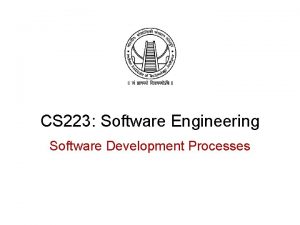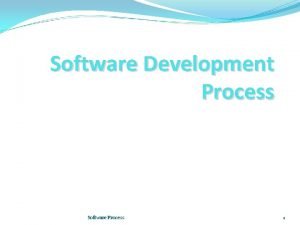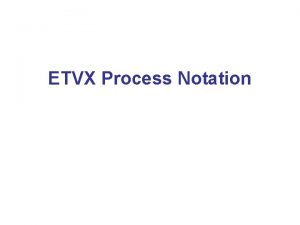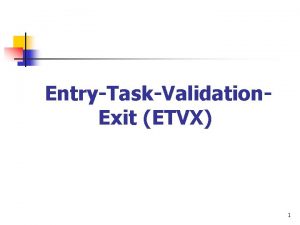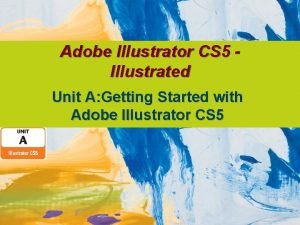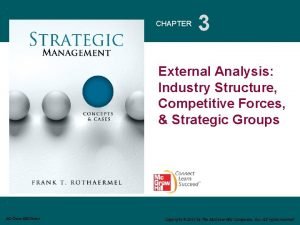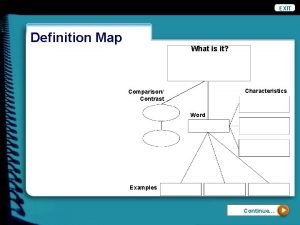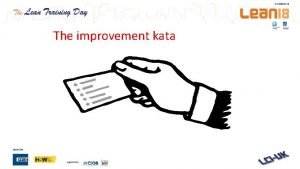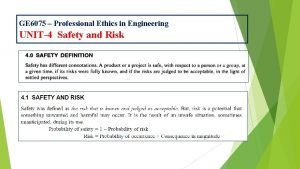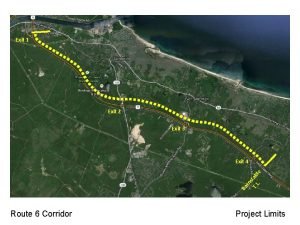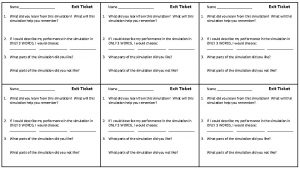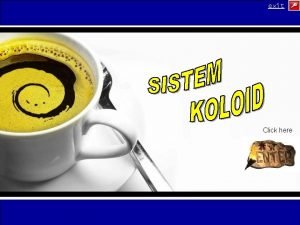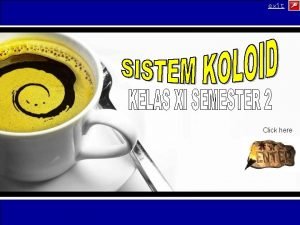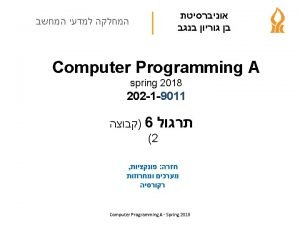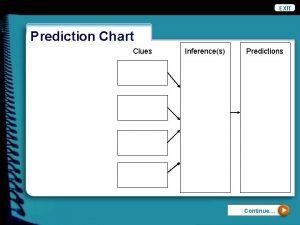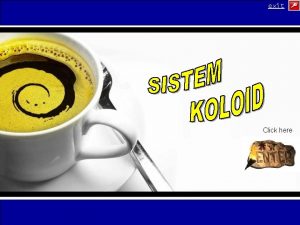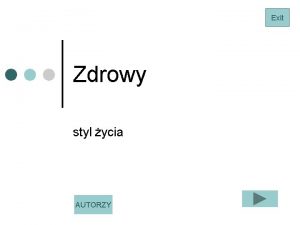EntryTaskValidation Exit ETVX 1 EntryTaskValidationExit ETVX n n













- Slides: 13

Entry-Task-Validation. Exit (ETVX) 1

Entry-Task-Validation-Exit (ETVX) n n n n ETVX method comes with ETVX diagrams to describe the Entry conditions, Tasks to be performed, Validation of the tasks and the Exit conditions. ETVX method is primarily for the description of activities, which are a set of tasks to be performed. This is not a method to depict the higher level or organizational level processes. ETVX uses a simple technique of identifying the four important phases of any activity at a sub process level. These four phases of any activity are Entry Criteria, Tasks to be performed, Exit Criteria and Validation, Verification Conditions for each task. The purpose of using a process definition method such as ETVX is to develop an operational definition of the activity under a process architecture. These operational definitions can then be adapted or tailored for use on all projects which uses the defined process architecture. 2

n To be operational, the documented process must put communicable meaning into the concepts and express the activity of the process or process itself in operational terms to: n n identify and define entry criteria to begin activity, probably a "from" activity for traceability, state or condition of inputs, eg. , work products or data used identify and define the individual atomic tasks, task descriptions of what is to be accomplished like enumerated procedures or steps, organizational roles, responsibilities, units or automation of performing the tasks, identify and define validation and verification procedures to verify quality of work items or work products produced by tasks, identify and define an exit criteria to complete the activity, in most cases with a state or condition of outputs, e. g. , work products or information produced, probably a "to" activity for traceability. 3

Process Model: ETVX n The Entry-Task-Validation-Exit (ETVX) model views processes within the context of: 1. Inputs or triggers 2. Tasks (also called procedures) 3. Controls 4. Constraints 5. Output 4

Factors and/or activities to control the process (policy, standards, SLAs, etc. ) CONTROL Tasks required to create process output Entry Criteria or Trigger Entry Criteria Tasks Validation Process Output Exit Criteria Ensure that all exit criteria have been satisfied CONSTRAINTS Correct any non- conformning or missing exit criteria Limitations (technical, procedural, etc. ) 5

Process components Entry Criteria: Inputs and Triggers n n Processes are initiated by either an input or a trigger. An input is usually an output from a preceding process; a trigger is an event that invokes the process. In either case, input or trigger, an associated list of entry criteria must be satisfied in order for the process to commence. Tasks n n Tasks (also called procedures) are the action components of a process. In the ETVX model tasks follow a sequence that has a validation step. This step ensures that the process does not pass its output to another process or terminate until all exit criteria have been satisfactorily met. Validation n This is a process checkpoint that occurs after the task(s) associated with the process have been completed. This checkpoint is also known as a quality gate - its purpose is to ensure that the task(s) have produced an output that meets specifications and/or requirements of the process. A failure at the validation checkpoint generally requires re-performing the process tasks. 6

Process components Exit Criteria n n All conditions that must be present and/or satisfied before a process can successfully terminate. Closely coupled to exit criteria is the output of the process itself; i. e. , what the process was designed to produce. All processes produce an output. Controls n n 1. 2. 3. 4. Process controls are limits that have been purposely placed on the process to prevent undesirable outcomes. Examples include: Policies. Checkpoints. Audits and integrity checking (i. e. , cyclic redundancy checks, etc. ) Error detection and correction processes. Constraints n n n Limitations imposed on a process are called constraints. Examples include technical capabilities, available time frames, resources, transmission speeds, etc. The key difference between a control and a constraint is that a control is designed into the process to produce or effect a desirable outcome, while a constraint is a limitation to the process (or environment) that may impact on the effectiveness and/or efficiency of the process. 7

ETVX Specification n n ETVX approach to specify a step n Entry criteria: what conditions must be satisfied for initiating this phase n Task: what is to be done in this phase n Verification: the checks done on the outputs of this phase n e. Xit criteria: when can this phase be considered done successfully A phase also produces information for management 8

ETVX approach 9

Sample ETVX Diagram 10

ETVX Example: Change management 11

Refrences n n n http: //www. oocities. org/goutamvs/PDM-ETVX. html http: //www. tarrani. net/mike/ETVXSummary. pdf https: //web. cs. dal. ca/~arc/teaching/CS 3130/Lectures /2 -Process. Models. ppt http: //www. philadelphia. edu. jo/academics/enaffar/up loads/2 -Software. Process. ppt Radice, R. A. ; Roth, N. K. ; O'Hara, A. C. , Jr; Ciarfella, W. A. " A Programming Process Architecture" IBM Systems Journal Vol. 24, No 2 (1985), pp. 79 -90. 12

conclusion n One approach for organizing data is “ETVX”, n Entry includes all inputs you require, internal and external to your project etc n Exit specifies all of your expected outputs n Task and validation provides information on the work you will need for estimation, execution and control. 13
 1/2 diagonal rule egress
1/2 diagonal rule egress Exit exit access and exit discharge
Exit exit access and exit discharge Pros and cons of iterative model
Pros and cons of iterative model Etvx model x is equivalent to
Etvx model x is equivalent to Etvx
Etvx Match the correct etvx criteria
Match the correct etvx criteria Adobe illustrator smart guides
Adobe illustrator smart guides Free entry and exit
Free entry and exit Client exit interview
Client exit interview Have i played the part well then applaud me as i exit
Have i played the part well then applaud me as i exit Exit summary example
Exit summary example Exit the map
Exit the map Exit condition
Exit condition Ge 6075
Ge 6075


